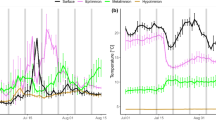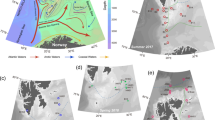Abstract
Diurnal variations in aquatic systems may be a major factor influencing carbon cycling. However, few studies have examined diurnal variation on floodplains and wetlands, especially in the tropics. Stable isotope analysis of dissolved inorganic carbon (δ13CDIC) provides insight into the driving factors behind diurnal physio-chemical variability, but to date, the manual collection of large sample numbers at high temporal frequency has been prohibitive. Here, we report one of the first, high-resolution isotopic studies of δ13CDIC on a tropical floodplain using acidification-interface cavity ring-down spectrometry. Water samples were analysed for δ13CDIC and other water quality parameters at 15-min intervals for 24 h. Our results show significant diurnal variation in both DIC concentration and δ13CDIC. Maximum DIC concentration, recorded overnight, was approximately 100 % greater than during the day. Maximum DIC concentration coincided with minimum δ13CDIC as a result of shifting autotrophic/heterotrophic balance. Changes were significant over small time scales and showed CO2 gas evasion estimates could vary by as much as 50 % based on measurements taken less than 5 h apart. These data show that to accurately evaluate the role of tropical floodplains in global carbon dynamics, a comprehensive understanding of diurnal variation will be essential.




Similar content being viewed by others
References
Bartlett KB, Crill PM, Bonassi JA, Richey JE, Harris RC (1990) Methane flux from the Amazon River floodplain: emissions during rising water. J Geophys Res 95:16773–16788
Bass AM, Waldron S, Preston T, Adams CE, Drummond J (2010) Temporal and spatial heterogeneity in lacustrine δ13CDIC and δ18ODO signatures in a large mid-latitude temperate lake. J Limnol 69:341–349
Bass AM, Bird MI, Liddell MJ, Nelson PN (2011) Fluvial dynamics of dissolved and particulate organic carbon during periodic discharge events in a steep tropical rainforest catchment. Limnol Oceanogr 56:2282–2292
Bass AM, Bird MI, Munksgaard NC, Wurster CM (2012) ISO-CADICA: isotopic—continuous dissolved inorganic carbon analyser. Rapid Commun Mass Sp 26:639–644
Beck AJ, Janssen F, Polerecky L, Herlory O, De Beer D (2009) Phototropic biofilm activity and dynamics of diurnal Cd cycling in a freshwater stream. Environ Sci Technol 43:7245–7251
Belger L, Forsberg BR, Melack JM (2011) Carbon dioxide and methane emissions from interfluvial wetlands in the upper Negro River basin, Brazil. Biogeochemistry 105:171–183
Bourg ACM, Bertin C (1996) Diurnal variations in the water chemistry of a river contaminated by heavy metals: natural biological cycling and anthropic influence. Water Air Soil Poll 86:101–116
Cole JJ, Prairie YT, Caraco NF, McDowell WH, Tranvik LJ, Striegel RG, Duarte CM, Kortelainen P, Downing JA, Middelburg JJ, Melack J (2007) Plumbing the global carbon cycle: integrating inland waters into the terrestrial carbon budget. Ecosystems 10:171–184
Devol AH, Richey JE, Forsberg BR, Martinelli LA (1994) Environmental methane in the Amazon River floodplain. In: Mitsch WJ (ed) Global wetlands: old World and new. Elsevier Science, Amsterdam, pp 151–165
Dinsmore KJ, Billett MF, Moore TR (2009) Transfer of carbon dioxide and methane through the soil-water-atmosphere system at Mer Bleue peatland, Canada. Hydrol Process 23:330–341
Dyson KE, Billett MF, Dinsmore KJ, Harvey F, Thomson AM, Piirainen S, Kortelainen P (2010) Release of aquatic carbon from two peatland catchments in E. Finland during the spring snowmelt period. Biogeochemistry 103:125–142
Finlayson CM (2005) Plant ecology of Australia’s tropical floodplain wetlands: a review. Ann Bot Lond 96:541–555
Finlayson CM, Cowie ID, Bailey BJ (1990) Sediment seedbanks in grassland on the Magela creek floodplain, northern Australia. Aquat Bot 38:163–176
Gammons CH, Nimick DA, Parker SR, Cleasby TE, McCleskey RB (2005) Diurnal behaviour of iron and other heavy metals in a mountain stream with acidic to neutral pH: fischer Creek, Montana, USA. Geochim Cosmochim Acta 69:2505–2516
Johnson MS, Billett MF, Dinsmore KJ, Wallin M, Dyson KE, Jassal RS (2010) Direct and continuous measurement of dissolved carbon dioxide in freshwater aquatic systems—method and applications. Ecohydrology 3:68–78
Kaplan LA, Bott TL (1982) Diurnal fluctuations of DOC generated by algae in a Piedmont stream. Limnol Oceanogr 27:1091–1100
Keeley JE (1990) Photosynthetic pathways in freshwater aquatic plants. TREE 5:330–333
Kuehn KA, Steiner D, Gessner MO (2004) Diurnal mineralization patterns of standing-dead plant litter: implications for CO2 flux from wetlands. Ecology 85:2504–2518
Maurice PA, Leff LG (2002) Hydrogeochemical controls on the organic matter and bacterial ecology of a small freshwater wetland in the New Jersey Pine Barrens. Water Res 36:2561–2570
Mayorga E, Aufdenkampe AK, Masiello CA, Krusche AV, Hedges JI, Quay PD, Richey JE (2005) Young organic matter as a source of carbon dioxide outgassing from Amazonian rivers. Nature 436:538–541
Melack JM, Hess LL, Gastil M, Forsberg BR, Hamilton SK, Novo EMLN, Lima IBT (2004) Regionalization of methane emissions in the Amazon basin with microwave remote sensing. Glob Change Biol 10:530–544
Miller RL (2011) Carbon gas fluxes in re-established wetlands on organic soils differ relative to plant community and hydrology. Wetlands 31:1055–1066
Mitsch WJ, Gosselink JG (2000) Wetlands third edition. Wiley, New York
Montety V, Martin JB, Cohen MJ, Foster C, Kurz MJ (2011) Influence of diurnal biogeochemical cycles on carbonate equilibrium in a karst river. Chem Geol 283:31–43
Nimick DA, Gammons CH, Parker SR (2011) Diurnal biogeochemical processes and their effect on the aqueous chemistry of streams: a review. Chem Geol 283:3–17
Parker SR, Poulson SR, Smith MG, Weyer CL, Bates KM (2010) Temporal variability in the concentration and stable isotope composition of dissolved organic and inorganic carbon in two Montana, USA rivers. Aquat Geochem 16:61–84
Petit NE, Bayliss P, Davies PM, Hamilton SK, Warfe DM, Bunn SE, Douglas MM (2011) Seasonal contrasts in carbon resources and ecological processes on a tropical floodplain. Freshwater Biol 56:1047–1064
Poulson SR, Sullivan AB (2010) Assessment of diurnal chemical and isotopic techniques to investigate biogeochemical cycles in the upper Klamath River, Oregon, USA. Chem Geol 269:3–11
Raymond PA, Bauer E, Cole JJ (2000) Atmospheric CO2 evasion, dissolved inorganic carbon production, and net heterotrophy in the York River estuary. Limnol Oceanogr 45:1707–1717
Richey JE, Melack JM, Aufdenkampe AK, Ballester MVR, Hess LL (2002) Outgassing from Amazonian rivers and wetlands as a large tropical source of atmospheric CO2. Nature 416:617–620
Rosenqvist A, Forsberg BR, Pimentel T, Rauste YA, Richey JE (2002) The use of spaceborne radar data to model inundation patterns and trace gas emissions in the central Amazon floodplain. Int J Remote Sens 33:1303–1328
Smith FA, Walker NA (1980) Photosynthesis by aquatic plants: effects of unstirred layers in relation to assimilation of CO2 and HCO3− and to carbon isotopic discrimination. New Phytol 86:245–259
Spencer RGM, Pellerin BA, Bergamaschi BA, Downing BD, Krauss TEC, Smart DR, Dahlgren RA, Hernes PJ (2007) Diurnal variability in riverine dissolved organic matter composition determined by in situ optical measurements in the San Joaquin River (California, USA). Hydrol Process 21:3181–3189
Supervising scientist (2010) Annual report 2009–2010. Supervising scientist, Darwin. http://www.environment.gov.au/ssd/publications/ss09-10/pubs/annual-report-09-10.pdf
Tobias C, Böhlke JK (2011) Biological and geochemical controls on diurnal dissolved inorganic carbon cycling in a low-order agricultural stream: implications for reach scales and beyond. Chem Geol 283:18–30
Volk CJ, Volk CB, Kaplan LA (1997) Chemical composition of biodegradable dissolved organic matter in stream water. Limnol Oceanogr 42:39–44
Waldron S, Scott ME, Soulsby C (2007) Stable isotope analysis reveals lower-order river dissolved inorganic carbon pools are highly dynamic. Environ Sci Technol 41:6156–6162
Wasson RJ (1992) Modern sedimentation and late quaternary evolution of the Magela Creek plain. Supervising scientist for Alligator rivers region report 6, Australian Government Publishing Service, Canberra, Australia
Waterloo MJ, Oliveira SM, Drucker DP, Nobre A, Cuartas LA, Hodnett MG, Langedijk I, Jans WWP, Tomasella J, Araújo AC, Pimentel TP, Estrada JCM (2006) Export of organic carbon in run-off from an Amazonian rainforest blackwater catchment. Hydrol Process 20:2581–2597
Zhou L, Zhou G, Jia Q (2009) Annual cycle of CO2 exchange over a reed (Phragmites australis) wetland in Northwest China. Aquat Bot 91:91–98
Ziegler SE, Fogel ML (2003) Seasonal and diurnal relationships between the isotopic compositions of dissolved and particulate organic matter in freshwater ecosystems. Biogeochemistry 64:25–52
Acknowledgments
The staff of the Wildman Ranger station is thanked for their assistance and willingness to provide logistical advice. We thank owners and staff of the Wildman Wilderness lodge for providing access to the study site. Comments from two anonymous reviewers substantially improved this manuscript.
Author information
Authors and Affiliations
Corresponding author
Rights and permissions
About this article
Cite this article
Bass, A.M., O’ Grady, D., Berkin, C. et al. High diurnal variation in dissolved inorganic C, δ13C values and surface efflux of CO2 in a seasonal tropical floodplain. Environ Chem Lett 11, 399–405 (2013). https://doi.org/10.1007/s10311-013-0421-7
Received:
Accepted:
Published:
Issue Date:
DOI: https://doi.org/10.1007/s10311-013-0421-7




